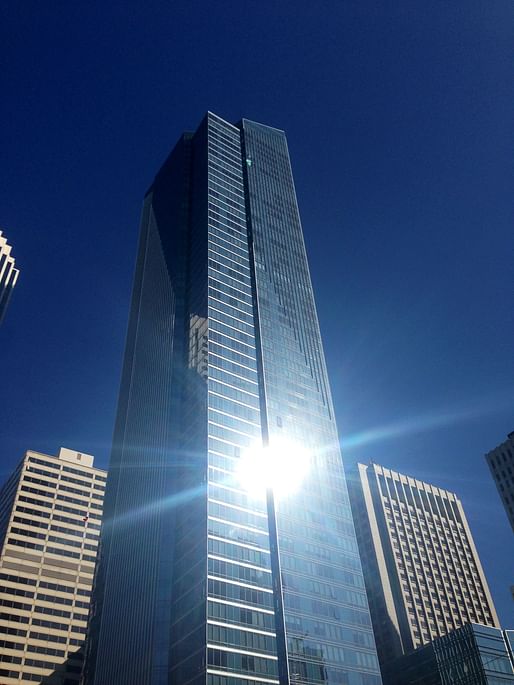

It’s doing it (again). San Francisco’s Millennium Tower is on the move once more, this time in an entirely different dimension as the 13-year-old building is sliding while it sinks and tilts.
Now the tower is said to be moving to the east, specifically. The firm in charge of stabilizing the former Handel project testified the 58-story building’s “horizontal movement” in documents that were provided to the city during last year, according to NBC Bay Area.
Ron Hamburger is back again as the engineer telling everybody they were essentially fine to occupy and that the building’s shift left has added another half inch since beginning construction on the perimeter pile upgrade late last summer, coupling with the 24-inch tilt on the roof to create an inch-wide gap between the tower’s foundation mat and adjacent building's five-floor underground garage.
He also predicted crucially that the sliding would not get any worse during the project, which is meant to stop the building from being yellow-tagged by the city. Once the construction eventually does stop he said it will ultimately help mitigate the tilt that has been measured as much as 6 and a half feet in the northwest direction.
An outside team also repaired an elevator which had been shut down due to code (and speculated to have a 2-inch gap). Hamburger addressed this too, saying that the retrofit will bring the entire system closer together once it is completed in January of next year.
The elevator system is still pending an additional inspection. Archinect will share any updates as soon as they become available.
16 Comments
Please get your act together we need peace of mind.
Who's 'we?'
We are the one's paying your salary.
You don't want to meet us.
You don't pay my salary in any way, shape, or form. We can agree that you're not someone I'd ever want to meet, however. Are you an unhappy billionaire who owns one of the units, perchance?
Gino, please tell me more.
.
Jeez, what else could go wrong? That building is like poor Nordberg here.
This guy doesn't seem too bright, in nature any movement generally increases the instability because the most stable configuration is how is was first designed to be. Like when you play Jenga and you remove a block that shifts the entire stack. That move made the structure less stable.
.https://www.youtube.com/watch?...
Cute
This story is amazing. They build a steel and concrete skyscraper and don't drive piles to the bedrock. It would have added millions of dollars to the cost but look what they are paying now. I still don't understand how they are going to fix it and neither do they. Now all the current owners are in limbo. They can't sell their unit because who would buy it at any price? It just amazed me high priced architects and engineers put this building up with no solution in sight.
I have no sympathy for the rich fucks left holding valueless property.
Given my experience in the industry, I would be surprised if anyone ever seriously debated not having piles to bedrock. Especially in corporate architecture. Your engineer would just say, "We can use this foundation system, it'll save $15mil." Once the GC or client hears that, you are never undoing it.
It is funny to me how easily some of those early decisions are made with little regard for the implications later, this is just the most ugly manifestation of it we've seen in a while.
I have a brother who is an architect and another an engineer. I've been watching this for a couple years now. Originally this was going to be steel but they switched to reinforced concrete. Any contractor can tell you that adds weight. A lot of weight. I know that when they design these they expect compaction which leads to sinking. But only an inch or two. What they used was 80 foot concrete friction piles. 950 of them. That sounds like plenty with room for comfort. The problem is the soil which they call Old Bay Clay. It's kind of a mud. Over time the weight caused water to be squeezed out of the clay. Who knows what they did to examine the clay. Like ultrasound or something like that. Could there be a void somewhere down there? I remember the 1989 earthquake and a big problem was liquefaction where the skaking loosened the soil. Think about compaction machines used in construction. They use vibration and weight to settle the soil. But that's used for things like roads and walkways. Infortunately the sliderules in this case were not much help because you can't actually get all the data. They should have known there was unlnown and drive piles to bedrock. I know it's a long way down but they wouldn't have needed 950. Another option could have been hybrid using both friction and piles to bedrock. It's the Costa Concorda of skyscrapers. Cost more to fix or even remove than to build it.
Read a story about a property manager who went to inspect the building for some clients who were thinking of leasing space in the building. He noticed the window sashes were at a true horizontal but the windows were seriously out of plumb. Someone had altered the sashes to cover-up the lean. He advised his clients to take a pass.
Block this user
Are you sure you want to block this user and hide all related comments throughout the site?
Archinect
This is your first comment on Archinect. Your comment will be visible once approved.